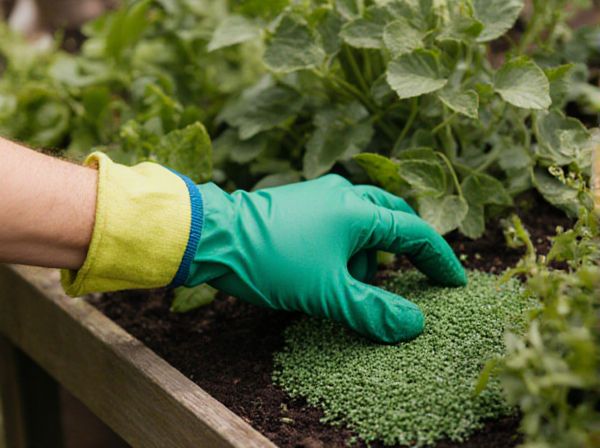
Green Materials vs Brown Materials Illustration
Green materials, such as fruit scraps, grass clippings, and coffee grounds, are rich in nitrogen and provide essential proteins for microbial activity in compost. Brown materials, including dry leaves, straw, and cardboard, supply carbon, which fuels the energy needs of decomposers and balances moisture. Proper mixing of green and brown materials accelerates decomposition, prevents odor, and produces nutrient-rich compost beneficial for soil health.
Table of Comparison
| Aspect | Green Materials | Brown Materials |
|---|---|---|
| Definition | Fresh, nitrogen-rich organic waste | Dry, carbon-rich organic matter |
| Examples | Vegetable scraps, grass clippings, coffee grounds | Dry leaves, straw, wood chips, paper |
| Carbon to Nitrogen Ratio (C:N) | Low (about 15:1) | High (about 30:1) |
| Role in Composting | Provides nitrogen to boost microbial activity | Supplies carbon to support energy for microbes |
| Moisture Content | High moisture | Low moisture |
| Decomposition Speed | Faster decomposition | Slower decomposition |
| Optimal Usage | Mix with brown materials to balance C:N ratio | Mix with green materials to optimize composting |
Understanding Green and Brown Materials in Composting
Green materials in composting, such as kitchen scraps, fresh grass clippings, and coffee grounds, provide essential nitrogen that fuels microbial activity for breaking down organic matter. Brown materials like dry leaves, straw, and cardboard contribute carbon, which balances moisture and structure, preventing compost from becoming too wet or compacted. Properly balancing green and brown materials accelerates decomposition and results in nutrient-rich, odor-free compost ideal for soil amendment.
Key Differences Between Green and Brown Compost Ingredients
Green materials in compost primarily consist of nitrogen-rich items such as vegetable scraps, coffee grounds, and grass clippings that accelerate microbial activity and heat production. Brown materials are carbon-rich substances like dry leaves, straw, and cardboard, which provide structure and aeration to the compost pile. Effective composting requires balancing green and brown ingredients to optimize decomposition, prevent odor, and promote nutrient-rich humus formation.
Benefits of Green Materials in Your Compost Pile
Green materials in compost piles, such as vegetable scraps, fresh grass clippings, and coffee grounds, provide essential nitrogen that accelerates microbial activity and speeds up decomposition. These nitrogen-rich inputs help balance the carbon-to-nitrogen ratio, ensuring efficient breakdown and producing nutrient-dense compost. Enhanced microbial diversity resulting from green materials improves soil fertility, promotes plant growth, and reduces the need for chemical fertilizers.
The Role of Brown Materials in Compost Decomposition
Brown materials, rich in carbon such as dry leaves, straw, and wood chips, play a crucial role in compost decomposition by providing the necessary carbon source that balances nitrogen-rich green materials. These carbon compounds fuel microbial activity, aiding in efficient breakdown and aeration of the compost pile, which prevents odor and promotes nutrient-rich humus formation. Maintaining an optimal carbon-to-nitrogen ratio, typically around 30:1, ensures a faster, balanced composting process with high-quality organic matter output.
Common Examples of Green and Brown Compost Materials
Green materials for compost typically include kitchen scraps like vegetable peels, fruit waste, coffee grounds, and grass clippings, all rich in nitrogen essential for microbial activity. Brown materials consist of dried leaves, straw, cardboard, and wood chips, providing carbon that balances and aerates the compost pile. Properly mixing common green and brown materials accelerates decomposition and produces nutrient-rich organic matter.
Balancing Green and Brown for Optimal Compost
Balancing green materials like vegetable scraps, coffee grounds, and fresh grass clippings with brown materials such as dry leaves, straw, and shredded cardboard creates the ideal carbon-to-nitrogen ratio crucial for efficient composting. Optimal compost decomposition occurs when the ratio is approximately 30:1 carbon to nitrogen, facilitating microbial activity and minimizing odors. Maintaining this balance ensures rich, nutrient-dense compost that enhances soil health and plant growth.
Impact of Imbalance: Too Much Green or Brown
An imbalance in composting, with too much green material like kitchen scraps and grass clippings, creates excess nitrogen that leads to a slimy, odor-prone pile. Excess brown materials such as dry leaves and cardboard increase carbon content, causing slow decomposition and poor nutrient release. Optimal compost requires a ratio of roughly 30 parts brown to 1 part green to ensure efficient microbial activity and healthy organic matter breakdown.
How to Layer Green and Brown Materials Effectively
Layering green and brown materials effectively in compost involves alternating nitrogen-rich green materials like vegetable scraps and grass clippings with carbon-rich brown materials such as dry leaves, straw, and cardboard. Maintaining a ratio of roughly 2:1 browns to greens ensures balanced decomposition, optimal moisture retention, and airflow within the compost pile. Proper layering accelerates microbial activity, reduces odors, and produces nutrient-rich humus beneficial for soil health.
Troubleshooting Compost: Green vs Brown Issues
Excessive green materials in compost, such as kitchen scraps and fresh grass clippings, can lead to a wet, smelly pile due to high nitrogen levels and inadequate aeration. Brown materials like dried leaves, straw, and cardboard provide carbon and improve structure, preventing compaction and odor problems. Balancing the carbon-to-nitrogen ratio between green and brown inputs is essential to maintaining effective microbial activity and efficient decomposition.
Eco-Friendly Sources for Green and Brown Compost Materials
Green materials in compost, such as kitchen scraps, grass clippings, and coffee grounds, provide essential nitrogen needed for microbial activity and rapid decomposition. Brown materials, including dried leaves, straw, and cardboard, contribute carbon that balances the compost's carbon-to-nitrogen ratio and enhances aeration. Utilizing eco-friendly sources like locally sourced vegetable waste for greens and recycled paper products for browns minimizes environmental impact while promoting sustainable composting practices.
Green Materials vs Brown Materials Infographic

 gardendif.com
gardendif.com